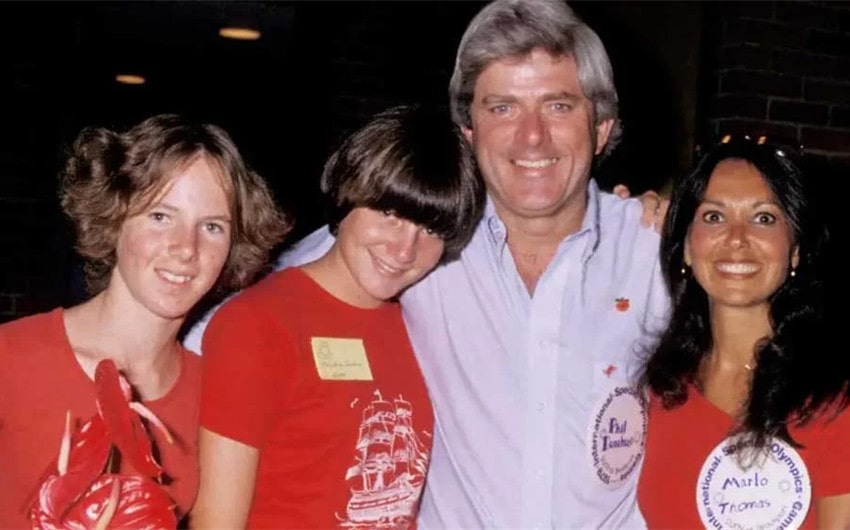Who Was Phil Donahue’s First Wife? The Untold Chapter Behind the TV Icon
You’ve probably seen clips of Phil Donahue standing in the middle of a lively audience, microphone in hand, breaking television norms with bold conversations. But long before he became a household name, there was a different part of his life that’s rarely discussed. That quieter chapter begins with Phil Donahue’s first wife, Margaret Cooney. While she never stood under the spotlight with him, her story is deeply woven into his early life—filled with young love, growing responsibilities, and the quiet strain that fame and ambition can bring. To understand the man, you have to understand the foundation he built with her, and how that foundation eventually cracked.
Who Was Phil Donahue’s First Wife?
Phil Donahue’s first wife was Margaret Cooney, a woman who lived most of her life away from cameras and headlines. Unlike Donahue, whose public image was shaped by decades of daytime television and social commentary, Cooney maintained her privacy, even as her former husband rose to become one of the most recognizable figures in media.
Donahue and Cooney married in 1958. At the time, he was just beginning his career, far from the stardom he would eventually achieve. They met young, fell in love quickly, and like many couples of their generation, started a family early. Together, they had five children—an impressive and demanding feat for any couple, let alone one navigating the early stages of a media career.
Margaret Cooney wasn’t a celebrity or a socialite. She wasn’t interested in interviews, red carpets, or public validation. And maybe that’s why you’ve heard so little about her. But her influence was undeniable. During the years they spent together, she was his partner, co-parent, and supporter during the formative years of his personal and professional development.
A Marriage Before the Spotlight
When you think of Phil Donahue now, you probably imagine the confident host of “The Phil Donahue Show”—a pioneer in talk TV, known for tackling controversial topics and giving the public a voice. But back in the 1950s and 1960s, he was still climbing. He worked as a production assistant and later a news anchor in Dayton, Ohio, before launching his talk show in 1967.
During those early years, Margaret Cooney was at home raising their children and managing the household. Donahue has spoken in interviews about the chaos and intensity of raising five children. There were diapers, scraped knees, homework, family dinners, and the quiet daily labor that builds a life—but rarely makes headlines. If you’ve ever tried to pursue a dream while raising a family, you know how that tug-of-war feels. One partner pushing forward in their career, the other holding everything together at home.
In many ways, Cooney’s contribution to Donahue’s success was invisible but critical. She made room for him to chase ambition while anchoring the family with consistency and care. It’s easy to forget how much strength that takes—especially when you’re doing it away from applause.
The Divorce: What Happened and What It Meant
Despite the strong beginnings, their marriage didn’t last. Donahue and Cooney divorced in 1975, after 17 years together. Like many long marriages, the reasons behind the split weren’t all made public. Donahue has been characteristically respectful of Cooney’s privacy, choosing not to air personal details. Still, it’s not hard to read between the lines.
Ambition, career growth, and the changing tides of personal identity often pull couples apart—especially when one partner moves into the public eye while the other stays behind. As Donahue’s talk show gained national traction, the balance in their relationship likely shifted. The demands of a rising media figure can create distance, emotional strain, and lifestyle differences that become harder to reconcile over time.
Their divorce marked a major turning point in Donahue’s life. It wasn’t just the end of a marriage—it was a moment that forced him to reevaluate his identity as a father, a partner, and a man in the public spotlight. He maintained close relationships with his children, continuing to show up in their lives even after the marriage ended. That, in itself, reflects a maturity and responsibility that often gets overlooked when discussing divorce.
If you’ve ever gone through the pain of a long relationship ending, you know how it can shake your world. But you also know that endings have a way of revealing new beginnings—sometimes slowly, sometimes all at once.
Life After the First Marriage
After the divorce, Margaret Cooney stepped fully out of public view. She didn’t write a memoir. She didn’t give interviews. And that silence isn’t emptiness—it’s choice. In a media-saturated world, she remained a private person, allowing the chapter of her life with Donahue to remain theirs, not the world’s.
Meanwhile, Phil Donahue eventually entered a new relationship—one that would become very public. In 1980, he married actress and activist Marlo Thomas. The two became a celebrated couple, known for their open dialogue about love, marriage, and independence. In many ways, their relationship became the subject of public fascination because it broke molds. They married later in life, chose not to have children together, and often spoke about how they managed to support each other’s independence.
This relationship with Thomas couldn’t have been more different from Donahue’s first marriage. But that doesn’t make it more important—just different. Margaret Cooney was part of his foundational years. She shared the chaos of raising a large family, the uncertainties of career-building, and the deeply personal experience of growing up together and eventually growing apart.
If you’ve ever moved from one long-term relationship into another, you understand how those chapters build upon each other. Each teaches you something different. Each shapes how you love, how you trust, and how you evolve.
What You Can Learn From Their Story
Phil Donahue’s first wife may not be famous. You won’t find her on talk shows or featured in retrospectives. But she mattered. Their marriage, though it ended, was formative. It gave Donahue a family, structure, and a grounding sense of purpose during his early years. It also offered the kind of life experience that likely informed his empathy and insight as a host.
You might look at your own relationships—past or present—and feel a mix of pride, loss, and gratitude. Some people aren’t meant to stay forever, but that doesn’t make their impact any smaller. Margaret Cooney was part of the scaffolding that supported Donahue before he became who he’s widely known as today.
There’s also something to be said about the dignity of silence. In a culture where people race to tell their side, Margaret Cooney chose not to. That restraint, that self-possession, is its own kind of strength. It reminds you that being impactful doesn’t always mean being visible.
And if you’ve ever had a relationship that ended without applause or recognition—but still shaped you in ways you can’t fully describe—you already understand that truth.
Featured Image Source: nameswhisper.com







